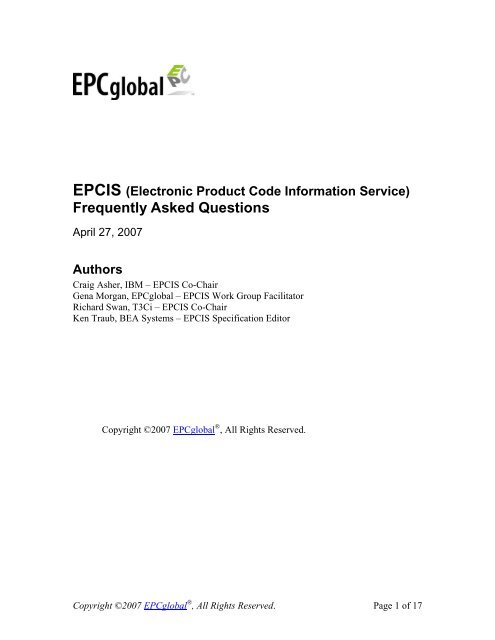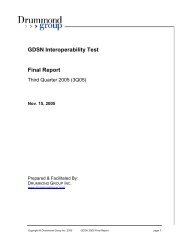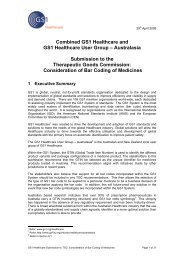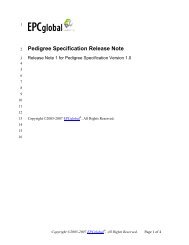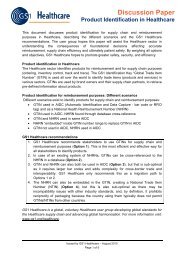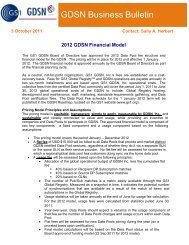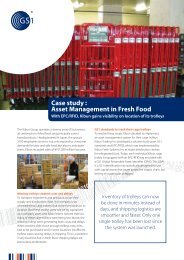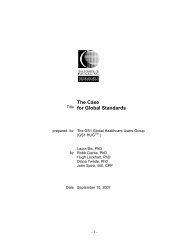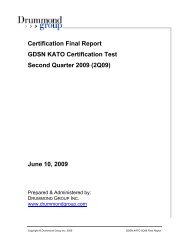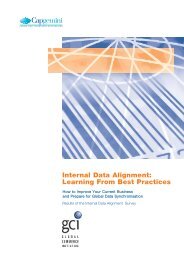EPCIS (Electronic Product Code Information Service) - GS1
EPCIS (Electronic Product Code Information Service) - GS1
EPCIS (Electronic Product Code Information Service) - GS1
Create successful ePaper yourself
Turn your PDF publications into a flip-book with our unique Google optimized e-Paper software.
<strong>EPCIS</strong> (<strong>Electronic</strong> <strong>Product</strong> <strong>Code</strong> <strong>Information</strong> <strong>Service</strong>)<br />
Frequently Asked Questions<br />
April 27, 2007<br />
Authors<br />
Craig Asher, IBM – <strong>EPCIS</strong> Co-Chair<br />
Gena Morgan, EPCglobal – <strong>EPCIS</strong> Work Group Facilitator<br />
Richard Swan, T3Ci – <strong>EPCIS</strong> Co-Chair<br />
Ken Traub, BEA Systems – <strong>EPCIS</strong> Specification Editor<br />
Copyright ©2007 EPCglobal ® , All Rights Reserved.<br />
Copyright ©2007 EPCglobal ® , All Rights Reserved. Page 1 of 17
Abstract<br />
The purpose of this document is to provide some clarity and insight in to the EPCglobal<br />
<strong>EPCIS</strong> v1.0 Standard. Included here are many basic questions about the value of <strong>EPCIS</strong>,<br />
the functionality of <strong>EPCIS</strong>, how <strong>EPCIS</strong> may be implemented, and probably most<br />
importantly, addresses some common misconceptions about <strong>EPCIS</strong>.<br />
Audience for this document<br />
This document attempts to describe and clarify the <strong>EPCIS</strong> standard, but does not describe<br />
the specifics of <strong>EPCIS</strong> as well as the standard document itself.. It attempts to explain<br />
<strong>EPCIS</strong> to a wide audience within the EPCglobal Community at multiple technical and<br />
business levels.<br />
Copyright ©2007 EPCglobal ® , All Rights Reserved. Page 2 of 17
EPC Basics<br />
1. Q: What is an EPC?<br />
A: An EPC, or <strong>Electronic</strong> <strong>Product</strong> <strong>Code</strong>, provides a unique, serialized identifier for any<br />
kind of object. Familiar identifiers can be encoded into an EPC format including:<br />
• GTIN (Global Trade Item Number)<br />
• GRAI (Global Returnable Asset Identifier)<br />
• SSCC (Serialized Shipping Container <strong>Code</strong>)<br />
• GIAI(Global Individual Asset Identifier)<br />
• CAGE/DoDAAC (US Department of Defense Internal Numbering SYsytem)<br />
The familiar EAN/UPC bar code, which encodes GTINs, provides identifying<br />
information for a class of item. EPC goes beyond this when a GTIN is encoded in an EPC<br />
by identifying an individual serialized item or instance of the item (sGTIN). Two cases<br />
of the same product will have the same GTIN, but will have different EPCs (sGTIN).<br />
2. Q: What products and assets can use EPC?<br />
A: Beyond being used at the item, case and pallet level for consumer products, an<br />
identifier such as GRAI ,GIAI or others could be encoded in an EPC and used to identify<br />
returnable containers, checked baggage, electronic products for warrantee and service<br />
needs, maintenance records on fixed assets, any level of container in national and<br />
international logistics, individually tracked vials of medication, or any other tangible<br />
object.<br />
3. Q: Why use EPC standards over earlier RFID specifications?<br />
A: RFID tags have been used for decades for mostly special purpose, proprietary<br />
tracking purposes. However, in modern commerce almost everything needs to move<br />
fluidly across enterprise boundaries. By providing open standards for tags, readers, and<br />
middleware EPCglobal has enabled the creation of a standards based industry where tags<br />
applied in one country can pass through many different organizations to their final<br />
destination and the identity of the object understood and authenticated. <strong>EPCIS</strong> is an<br />
additional EPCglobal standard that supports a detailed representation of the location and<br />
state of material as it moves between organizational boundaries and provides for sharing<br />
this in a technology supplier independent way between entities or partners. It should be<br />
noted that the <strong>EPCIS</strong> standard is data carrier neutral and can be used to exchange data<br />
found from RFID tags, barcodes and other data carriers.<br />
Copyright ©2007 EPCglobal ® , All Rights Reserved. Page 3 of 17
4. Q: What is the EPCglobal Network?<br />
A: The EPCglobal Network is a community of trading partners engaged in the capture<br />
and sharing of EPC-related data through use of EPCglobal standards based technologies.<br />
<strong>EPCIS</strong> is a one component of the EPCglobal Standards suite that supports the EPCglobal<br />
Network.<br />
<strong>EPCIS</strong> and Your Business<br />
5. Q: What is “<strong>EPCIS</strong>”?<br />
A: <strong>Electronic</strong> <strong>Product</strong> <strong>Code</strong> <strong>Information</strong> <strong>Service</strong>s (<strong>EPCIS</strong>) is an EPCglobal standard for<br />
sharing EPC related information between trading partners. <strong>EPCIS</strong> provides important<br />
new capabilities to improve efficiency, security, and visibility in the global supply chain,<br />
and complements lower level EPCglobal tag, reader, and middleware standards.<br />
6. Q: What information can be shared via <strong>EPCIS</strong> standards?<br />
A: The What, Where, When, and Why of events occurring in any supply chain is<br />
exchanged, safely and securely, via the <strong>EPCIS</strong> standard. This is important business<br />
information, such the time, location, disposition and business step of each event that<br />
occurs during the life of an item in the supply chain.<br />
7. Q: How is supply chain information shared via the <strong>EPCIS</strong> standard?<br />
A: The <strong>EPCIS</strong> standard provides interface specifications built on top of very widely used<br />
business and Internet standards. <strong>EPCIS</strong> facilitates internal data capture as well as secure<br />
external sharing of information about movement and status of goods in the physical<br />
world.<br />
8. Q: Why should my company use <strong>EPCIS</strong> standards?<br />
A: If your business involves handling physical goods – for example, if your organization<br />
is a manufacturer, distributor, logistics provider, reseller or large end user of tangible<br />
goods – then you probably already consume information internally or exchange<br />
information externally about the location and status of material. The <strong>EPCIS</strong> standard<br />
provides a path for cost-effectively sharing information with a much finer granularity of<br />
detail. Opportunities for better visibility and more efficiency are likely to draw many<br />
companies into adopting the standard which will complement identification and data<br />
sharing technology used today.. By using the <strong>EPCIS</strong> standard, your company is<br />
leveraging the experiences and learnings of other companies who created the<br />
specification and benefiting from the ease of sharing information when a single language<br />
is used.<br />
Copyright ©2007 EPCglobal ® , All Rights Reserved. Page 4 of 17
9. Q: Why should I use the <strong>EPCIS</strong> standard if I do not wish to share data with other<br />
trading partners?<br />
A: <strong>EPCIS</strong> is the bridge between the physical world and information systems. Many<br />
businesses have completely internal business processes that involve the handling of<br />
goods, and <strong>EPCIS</strong> provides a standard way of managing visibility into those processes.<br />
The benefits of giving business applications visibility into the physical world are as<br />
compelling within the four walls as they are between trading partners.<br />
Using EPCglobal standards within the corporation will ensure a wide choice of vendors<br />
and interoperability between vendors and allow for the bringing together of disparate<br />
systems within an organization. The <strong>EPCIS</strong> standard can connect a factory to a<br />
warehouse to a store that may be using different systems to collect data about product<br />
movement and status. Clearly, if situations change and there is a need to share previously<br />
internal information with another subsidiary or trading partner, this will be greatly<br />
facilitated by using standards.<br />
10. Q: Does the <strong>EPCIS</strong> standard replace EDI standards?<br />
A: No. The <strong>EPCIS</strong> standard provides a way to share high volume, very fine grain<br />
information about material movement and status among cooperating partners. <strong>EPCIS</strong><br />
does not address purchasing, forecasts, bidding, billing, etc. that are typically exchanged<br />
via EDI in a business transaction between two parties.<br />
Copyright ©2007 EPCglobal ® , All Rights Reserved. Page 5 of 17
11. Q: How can <strong>EPCIS</strong> provide a single standard for so many different industries?<br />
A: Despite widespread differences in how different businesses operate, all have processes<br />
that involve the physical movement of goods. All industries need to describe the physical<br />
movement of goods. The <strong>EPCIS</strong> standard at its foundation is universal language for<br />
describing information related to visibility of the physical world, incorporating common<br />
notions of What Where When and Why.<br />
<strong>EPCIS</strong> provides the flexibility for industries, user groups, and/or individual end-users to<br />
specify vocabularies and minimum best practices for their trading communities, where<br />
there may be specific requirements that may not be a part of the core components of the<br />
specification. For example,<br />
Business events all occur at a point in time. The meaning of time is universal to all<br />
industries and end users, and so the <strong>EPCIS</strong> core specification for “time” will serve all<br />
industries. Likewise, business events will happen at a particular place. All industries have<br />
a requirement to represent where an event took place by identifying its location, and so<br />
the <strong>EPCIS</strong> core specification has a place for “location” in the data model. However, each<br />
industry may have different conventions for representing location information, and so the<br />
<strong>EPCIS</strong> specification allows each industry to tailor location information to meet its needs.<br />
As a final example, all industries have a requirement to represent in which step of a<br />
business process an event occurred, but a particular business process step may not exist<br />
across all industries. The specification allows for industry specific data elements and core<br />
elements to co-exist, with the ultimate goal being to incorporate all commonly shared<br />
elements into the core specification.<br />
EPCglobal is currently developing cross-industry standard vocabulary values for the key<br />
elements of <strong>EPCIS</strong> – business step, disposition (status), location master data, and<br />
business transaction.<br />
12. Q: EPC is in early stages of wide scale adoption, how does <strong>EPCIS</strong> accommodate<br />
experimentation and new needs?<br />
A: The <strong>EPCIS</strong> framework is extensible and therefore allows new industry requirements<br />
to co-exist alongside the core components of the standard. The extensibility allows for<br />
experimentation and new requirements development while still providing<br />
interoperability.<br />
Copyright ©2007 EPCglobal ® , All Rights Reserved. Page 6 of 17
Common Questions based on Misconceptions about<br />
<strong>EPCIS</strong><br />
13. Q. Is <strong>EPCIS</strong> a large scale enterprise application designed by a committee?<br />
A: <strong>EPCIS</strong> is not an application. <strong>EPCIS</strong> is a standard that defines interfaces for<br />
representation and exchange of data. The <strong>EPCIS</strong> interface standards support applications,<br />
by specifying a data and communication format. The <strong>EPCIS</strong> standard provides what is<br />
necessary to share data, but does not provide application level functionality.<br />
14. Q: Does <strong>EPCIS</strong> have a sufficient level of functionality for an enterprise application?<br />
A: <strong>EPCIS</strong> is not an application. The <strong>EPCIS</strong> standard is a set of interfaces that support<br />
sharing of visibility data. This is similar to email protocols supporting the distribution of<br />
Internet mail. <strong>EPCIS</strong> defines a capture interface and a query interface to obtain and share<br />
business event information. The standard may be implemented by applications, but the<br />
applications themselves are developed by end users and solution providers – not<br />
EPCglobal. Those applications are expected to be quite diverse in their actual<br />
implementation.<br />
15. Q. Is <strong>EPCIS</strong> a track and trace/visibility application?<br />
A. <strong>EPCIS</strong> is not an application. <strong>EPCIS</strong> specifies a standard representation of and<br />
interface to visibility data, at a finer granularity than prior standards. <strong>EPCIS</strong> data may be<br />
used as input to track and trace or visibility applications, and that input will in all<br />
likelihood improve those applications due to the finer granularity of information offered<br />
by <strong>EPCIS</strong>.<br />
Copyright ©2007 EPCglobal ® , All Rights Reserved. Page 7 of 17
16. Q. Is <strong>EPCIS</strong> the same thing as ONS?<br />
A. No. Object Naming <strong>Service</strong> (ONS) can be thought of as a lookup service that takes an<br />
EPC as input, and produces as output the address (in the form of a Uniform Resource<br />
Locator, or URL) of an <strong>EPCIS</strong> repository designated and implemented by the EPC<br />
Manager of the EPC in question. <strong>EPCIS</strong>, on the other hand, provides the means to<br />
communicate further information about an individual EPC.<br />
EPCglobal Core <strong>Service</strong>s<br />
Subscriber<br />
Authentication<br />
(TBD)<br />
(TBD)<br />
EPCglobal Subscriber<br />
<strong>EPCIS</strong> Query Interface<br />
<strong>EPCIS</strong> Data Specification<br />
EPC Tag Data Specification<br />
Tag Protocol (UHF Class 1 Gen 2, et al)<br />
RFID Tag<br />
<strong>EPCIS</strong><br />
Discovery<br />
(TBD)<br />
(TBD)<br />
Subscriber’s Internal<br />
EPC Infrastructure:<br />
Readers, Data Collection<br />
Software, Repositories,<br />
Enterprise Applications,<br />
etc.<br />
Local<br />
ONS<br />
ONS<br />
Interface<br />
ONS<br />
Root<br />
ONS I’face<br />
Partner EPCglobal Subscriber<br />
<strong>EPCIS</strong> Accessing<br />
Application<br />
“Pull”or “Push” mode<br />
Manager<br />
Number<br />
Assignment<br />
(offline service)<br />
= HW/SW Role<br />
= Interface (EPCglobal<br />
Standard)<br />
Carried on physical object delivered to EPCglobal subscriber<br />
Copyright ©2007 EPCglobal ® , All Rights Reserved. Page 8 of 17<br />
Key<br />
Note that items marked “TBD” are<br />
placeholders for future work. The<br />
actual architecture of these items<br />
may ultimately be different from<br />
what’s depicted here.
17. Q: Is ONS required to deploy <strong>EPCIS</strong>?<br />
A: <strong>EPCIS</strong> can be deployed today without need for ONS or other discovery mechanism. .<br />
ONS or other discovery mechanisms become necessary when you do not know where to<br />
go to get information about a particular EPC. On the other hand, for many industries<br />
there are already established direct or indirect business relationships between trading<br />
partners, where partners are known to one another and secure exchange can take place<br />
without ONS or other discovery service. As EPC gets more widely deployed and used in<br />
industries with more dynamic routing, future EPCglobal standards based approaches to<br />
discover the identity of the relevant <strong>EPCIS</strong> will become valuable.<br />
18. Q: Is there a master, centralized <strong>EPCIS</strong>?<br />
A: There is no central implementation of <strong>EPCIS</strong>. <strong>EPCIS</strong> is not an application. No single<br />
organization or small set of organizations holds the data generated everywhere. EPC<br />
information is collected and owned by the organization collecting the data, by however<br />
manner they choose. For example this might be an individual carrier at an airport, a<br />
distributor with three warehouses, a manufacturer, a sea port, a bonded warehouse, or a<br />
large retail chain. If that organization wishes to share the data with trading partners they<br />
can choose to provide an <strong>EPCIS</strong> interface to that data. Each trading partner could then<br />
access, on request, any portion of the information for which they are authorized. No<br />
central repository is needed and the scale of sharing is unbounded in just the same way<br />
that new web servers can be added to the World Wide Web.<br />
19. Q. Can <strong>EPCIS</strong> scale?<br />
A. Yes. The standard is defined as a common way to express occurrences in the physical<br />
world. Because the <strong>EPCIS</strong> standard only defines interfaces, not implementations, the<br />
specification itself does not constrain implementations in any way that would affect<br />
scalability.<br />
Copyright ©2007 EPCglobal ® , All Rights Reserved. Page 9 of 17
20. Q: Is EPC and <strong>EPCIS</strong> just for Consumer Packaged Goods (CPG)?<br />
A: No: both EPC and <strong>EPCIS</strong> are designed for use by all industries, not just CPG. The<br />
consumer packaged goods industry has driven large scale demand for EPC compliant<br />
tags, readers and various layers of software. This has driven costs down rapidly. However<br />
from its inception, EPC was designed to be a technology that is very broadly applicable<br />
across multiple industries. The volumes driven from CPG make it more cost effective for<br />
other industries to adopt EPC. Even more important, all industry verticals involved in the<br />
movement of tangible material overlap at nexus points such as airports, distribution<br />
centers, customs processing, freight services, hazardous material regulations, etc. Thus,<br />
while different industries may have very different internal business processes, when<br />
products are unloaded from a truck, it is important that all the tags interoperate with the<br />
readers and that data can be exchanged freely independent of the origin of the material.<br />
21. Q. Do I have to participate in the EPCglobal Network to use <strong>EPCIS</strong>?<br />
A. No. The EPCglobal Network is a community of trading partners engaged in the capture<br />
and sharing of EPC-related data through use of EPCglobal standards based technologies.<br />
<strong>EPCIS</strong> is a component of the EPCglobal Network, but may also be used within four wall<br />
applications that may not require all EPCglobal standard components.<br />
Copyright ©2007 EPCglobal ® , All Rights Reserved. Page 10 of 17
22. Q. Do I have to be an EPCglobal member to use <strong>EPCIS</strong>?<br />
A. No. The <strong>EPCIS</strong> Standard is publicly available. Moreover, there are many solution<br />
providers that provide <strong>EPCIS</strong> compliant solutions, and EPCglobal membership is not<br />
required to purchase and use those solutions.<br />
EPCglobal membership does have its privileges. As a member you are entitled to the<br />
following:<br />
o Participation in the ongoing development of business-driven use cases and<br />
standards for the EPCglobal Network of Standards.<br />
� Links with other subscribers to create pilots and test cases.<br />
o EPCglobal community management by working with government,<br />
industry associations and other standards bodies<br />
o Intellectual property rights that are afforded to EPCglobal Subscriber<br />
o Access to best practices regarding consumer privacy and public policy.<br />
o Access to certification and compliance testing.<br />
o Training and education on implementing and using the EPC and the<br />
EPCglobal Network of Standards through the <strong>GS1</strong> Member Organizations<br />
� Access to <strong>GS1</strong>’s 30+ year expertise<br />
� User driven and governed (all supply chain roles)<br />
� Global implementation support (103 offices)<br />
� Support large, medium and small companies<br />
� Not for profit standards organization<br />
Copyright ©2007 EPCglobal ® , All Rights Reserved. Page 11 of 17
<strong>EPCIS</strong> in a Little More Detail<br />
23. Q: What is specified in the <strong>EPCIS</strong> standard?<br />
A: The <strong>EPCIS</strong> standard specifies two interfaces and a data model.<br />
The <strong>EPCIS</strong> Data Model specifies a standard way to represent visibility information about<br />
physical objects, including descriptions of product movements in a supply chain. The<br />
main components of the data model include EPC, Event Time, Business Step,<br />
Disposition, Read Point, Business Location, and Business Transaction. The data model is<br />
designed to be extended by industries and end users without revising the specification<br />
itself. Some extensions that have been used in <strong>EPCIS</strong> pilots to-date include Expiration<br />
Date, Batch Number, and Temperature.<br />
Visibility information in <strong>EPCIS</strong> takes the form of “events” that describe specific<br />
occurrences in the supply chain. An example event would be that EPC 123 (product) was<br />
Received (business step) in Non Sellable condition (disposition) at Distribution Center X<br />
(location) yesterday at 2pm EDT (time). A quick way to summarize the components of<br />
an <strong>EPCIS</strong> event are what (product), when (time), where (location), and why (business step<br />
and disposition).<br />
The <strong>EPCIS</strong> Event Capture Interface specifies a standard way for business applications<br />
that generate visibility data to communicate that data to applications that wish to<br />
consume it. In many cases, the receiving side of the Event Capture Interface will be a<br />
repository, but this is not necessarily the case.<br />
The <strong>EPCIS</strong> Query Interface provide a standard way for internal and external systems to<br />
request business events from repositories and other sources of <strong>EPCIS</strong> data using a simple,<br />
parameter-driven query language. There are two types of queries – Poll Queries for a<br />
synchronous, on-demand response, and Subscription Queries for an asynchronous,<br />
scheduled response.<br />
Copyright ©2007 EPCglobal ® , All Rights Reserved. Page 12 of 17
24. Q: So <strong>EPCIS</strong> is a repository?<br />
A: No. The <strong>EPCIS</strong> specification only specifies interfaces, not implementations. .Many<br />
types of applications may implement the interfaces. A repository is certainly one such<br />
type of application, but not the only type. A pure <strong>EPCIS</strong> repository application might<br />
implement the <strong>EPCIS</strong> Event Capture Interface to receive events, store them in a relational<br />
database, XML database, file system, or other persistent store, and implement the <strong>EPCIS</strong><br />
Query Interface to make those events available to other applications.<br />
A Warehouse Management System application, in contrast, carries out many more<br />
functions than pure storage of events; nevertheless it may too implement <strong>EPCIS</strong><br />
interfaces. For example, it might implement the <strong>EPCIS</strong> Capture Interface so that <strong>EPCIS</strong><br />
data may serve as one of many sources of input data. Likewise, it might implement the<br />
<strong>EPCIS</strong> Query Interface to expose visibility information to other applications, where that<br />
visibility information was calculated from other inputs, though not necessarily<br />
exclusively from the <strong>EPCIS</strong> Capture Interface.<br />
ERP systems, track-and-trace applications, visibility services, and others are all examples<br />
of applications that might implement one or both of the <strong>EPCIS</strong> interfaces. Nothing in the<br />
<strong>EPCIS</strong> specification limits its use to one type of application or another.<br />
25. Q: What are the data elements in the <strong>EPCIS</strong> standard?<br />
A: The data elements in the <strong>EPCIS</strong> standard data model define WHAT (product),<br />
WHERE (location), WHEN (time), and WHY (business step and status) for granular<br />
product movements in the supply chain.<br />
WHAT<br />
• EPC – can be a list (Object or Transaction Events) or parent/child (Aggregation or<br />
Transaction Events). It is possible to include any unique identity in the EPC field.<br />
• Business Transaction – includes a type (e.g.: Purchase Order, Invoice, Bill of<br />
Lading) and a number. By including the Business Transaction number in a<br />
business event, it is possible to relate EPCs to a Business Transaction – e.g.: state<br />
that EPCs 1-5 are in Purchase Order CompanyA-123.<br />
WHERE<br />
• Read Point – indicates the location where an event took place – e.g.: DC X<br />
conveyor belt #2<br />
• Business Location – describes where the object is immediately after the event<br />
occurs – e.g.: DC X Shipping Area<br />
WHEN<br />
• Event Time – states when an event took place<br />
• Record Time – indicates when the event was received through the <strong>EPCIS</strong> Capture<br />
Interface<br />
Copyright ©2007 EPCglobal ® , All Rights Reserved. Page 13 of 17
WHY<br />
• Business Step – indicates what business operation was taking place at the time of<br />
the event – e.g.: Receiving, Picking, Loading, Shipping<br />
• Disposition – describes the status of the product immediately after the event<br />
occurs – e.g.: Sellable, In Progress, Non Sellable, Destroyed<br />
The final standard field is Action, which has three values:<br />
1. Add – indicates the first event in a product’s lifecycle for an Object Event, or<br />
indicates joining child EPCs to a parent EPC in an Aggregation Event<br />
2. Observe – indicates an event between beginning of life and end of life for an Object<br />
Event<br />
3. Delete – indicates the last event in a product’s lifecycle for an Object Event, or<br />
indicates removing child EPCs from a parent EPC in an Aggregation Event<br />
26. Q: How can implementers extend the data elements in the <strong>EPCIS</strong> standard?<br />
A: Implementers can freely define field names in the Extension section of the XML data<br />
model. It is readily possible to capture and query for extension fields. Many pilots todate<br />
have successfully used the extension capability – with examples including<br />
Expiration Date, Batch Number, Temperature, Receiver Name, and Shipper Name.<br />
27. Q: What are the appropriate values for the data elements in the <strong>EPCIS</strong> standard?<br />
A: The <strong>EPCIS</strong> specification does not define required values for many data elements.<br />
Instead it leaves the definition to trading partners.<br />
Within the EPCglobal Data Exchange Joint Requirements Group, we are well-underway<br />
in defining standard values for the data elements involved in sharing business events<br />
between trading partners. These data elements are Business Step, Disposition, Business<br />
Location, and Business Transaction Type. This Joint Requirements Group currently has<br />
membership from the Retail, Consumer <strong>Product</strong>s, Health Care & Life Sciences, Transport<br />
& Logistics, and Aerospace industries.<br />
EPCglobal defines the standard values for the EPC code within the Tag Data Standards<br />
specification.<br />
28. Q: What are the business events specified in the <strong>EPCIS</strong> standard?<br />
A: There are four business events defined in the <strong>EPCIS</strong> 1.0 specification.<br />
• Object Event – describes an event pertaining to an EPC as it moves through the<br />
supply chain – from birth (ADD) through midlife (OBSERVE) to death<br />
(DELETE).<br />
• Aggregation Event – describes an event pertaining to a physical aggregation of<br />
child EPCs to a parent EPC, such as cases aggregated to a pallet. It is possible to<br />
Copyright ©2007 EPCglobal ® , All Rights Reserved. Page 14 of 17
include EPCs in an aggregation (ADD), see EPCs in an aggregation (OBSERVE),<br />
or remove EPCs from an aggregation (DELETE). It is possible to express any<br />
number of levels of aggregation – e.g.: Unit to Inner Case to Outer Case to Pallet<br />
to Shipping Container.<br />
• Transaction Event – describes the definitive association or disassociation of one<br />
or more EPCs to a Business Transaction. It is possible to include a hierarchy in a<br />
Transaction Event – e.g.: Pallet EPC 1 with Case EPCs 10-20 are in Purchase<br />
Order CompanyB-4567.<br />
• Quantity Event – describes events pertaining to products without serialized EPCs.<br />
These events include a <strong>Product</strong> Class (e.g.: GTIN), a Quantity, a Business<br />
Location, and Time. These events can be used for capturing inventory or point of<br />
sale data – e.g.: one hour ago there were 10 units of <strong>Product</strong> X in Storeroom Y or<br />
yesterday Store A sold 5 units of <strong>Product</strong> B.<br />
The specification enables adding other business events as required in the future.<br />
29. Q: How is <strong>EPCIS</strong> data secured?<br />
A: There are two forms of data security described in the <strong>EPCIS</strong> specification –<br />
authentication and authorization.<br />
1. Authentication – the <strong>EPCIS</strong> standard enables the use of multiple message transport<br />
bindings that include authentication – including SOAP over HTTP with TLS (web<br />
services) and XML over AS2. The implementation of the bindings are defined<br />
outside the <strong>EPCIS</strong> standard.<br />
2. Authorization – an implementation of the <strong>EPCIS</strong> Query Interface may use the<br />
authenticated identity of the requester, together with arbitrary business rules, to<br />
decide which events to deliver to the requestor and which information to include<br />
within those events. The <strong>EPCIS</strong> specification itself does not specify what those<br />
business rules are – it is up to each implementation to use authorization rules that are<br />
appropriate given its own business situation. The specification defines what types of<br />
data may be withheld, and includes a standard error message to be provided when the<br />
<strong>EPCIS</strong> wishes to deny access to data entirely – i.e.: SecurityException.<br />
30. Q: How does the <strong>EPCIS</strong> standard define error conditions?<br />
A: The <strong>EPCIS</strong> standard provides a range of standard errors that can be raised by an<br />
implementation when responding to a query. These errors include Query Parameter<br />
Exception (a query parameter is invalid), Query Too Large Exception, Subscription<br />
Controls Exception (invalid control definition for a subscription query), Validation<br />
Exception (query syntax not correct), Security Exception (query not permitted), and<br />
Implementation Exception (implementation had a failure).<br />
Copyright ©2007 EPCglobal ® , All Rights Reserved. Page 15 of 17
31. Q: How did you test that the <strong>EPCIS</strong> standard works?<br />
A: Twelve large and small solution providers from Japan, Korea, and North America met<br />
in July 2006 to thoroughly test their ability to interoperate using the prototype <strong>EPCIS</strong><br />
specification. We used test cases from the EPCglobal <strong>EPCIS</strong> pilots. Based on the<br />
successful interoperability event and the minor changes that we made to the <strong>EPCIS</strong><br />
standard to further ease interoperability, we are confident that the final <strong>EPCIS</strong> standard<br />
will work well in deployments.<br />
<strong>EPCIS</strong> and Implementation<br />
32. Q: How might a sample implementation work for a small company?<br />
A: There is no standard definition of an <strong>EPCIS</strong> implementation. But based on our<br />
experience from the <strong>EPCIS</strong> pilots, we can provide some thoughts.<br />
A small company could first determine how it would like to capture and share <strong>EPCIS</strong><br />
business events. For data capture, the company could set up EPC readers and<br />
middleware. For data sharing, the company could make arrangements with its trading<br />
partners to monitor shipments and receipts of EPC-tagged products.<br />
The company would need to compile master data for the products and locations in its<br />
supply chain.<br />
Then the small company could set up an <strong>EPCIS</strong> repository application with help from a<br />
solution provider. The company would load the master data into its repository. The<br />
company could route its captured <strong>EPCIS</strong> events from its middleware to its <strong>EPCIS</strong><br />
repository via the capture interface. Then the company could set up subscription queries<br />
with its trading partners to track all shipments and receipts.<br />
There are many known use cases for <strong>EPCIS</strong> based on our current pilots. These use cases<br />
include electronic proof of delivery (e.g.: tracking receiving & shipping between trading<br />
partners), electronic pedigree (e.g.: tracking which trading partners had custody of an<br />
EPC in the supply chain), product authentication (e.g.: verifying the manufacturer of an<br />
EPC), promotional compliance (e.g.: ensuring that displays of sale product are setup on<br />
time in stores), and inventory management (e.g.: detecting when a product goes out of<br />
stock). A company will typically enable these use cases by building applications on their<br />
base <strong>EPCIS</strong> infrastructure.<br />
Copyright ©2007 EPCglobal ® , All Rights Reserved. Page 16 of 17
33. Q: How do I integrate the <strong>EPCIS</strong> interfaces with my existing systems?<br />
A: The <strong>EPCIS</strong> standard does not mandate any implementation or repository. So it is<br />
possible for an end-user to build the <strong>EPCIS</strong> interfaces and data model themselves on top<br />
of an existing enterprise system. But it may be simpler for many organizations to buy an<br />
<strong>EPCIS</strong> repository application from a solution provider, or obtain <strong>EPCIS</strong>-compliant<br />
application enhancements from their existing application providers. A company could<br />
leverage their <strong>EPCIS</strong> repository for capturing business events from middleware,<br />
integrating the <strong>EPCIS</strong> repository into the enterprise architecture via web services, and<br />
allowing trading partners to access data in the <strong>EPCIS</strong> repository in a secure manner via<br />
the query interface.<br />
Copyright ©2007 EPCglobal ® , All Rights Reserved. Page 17 of 17


